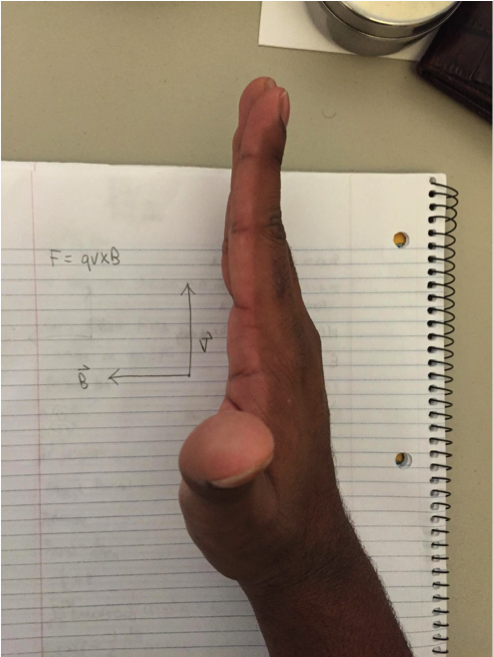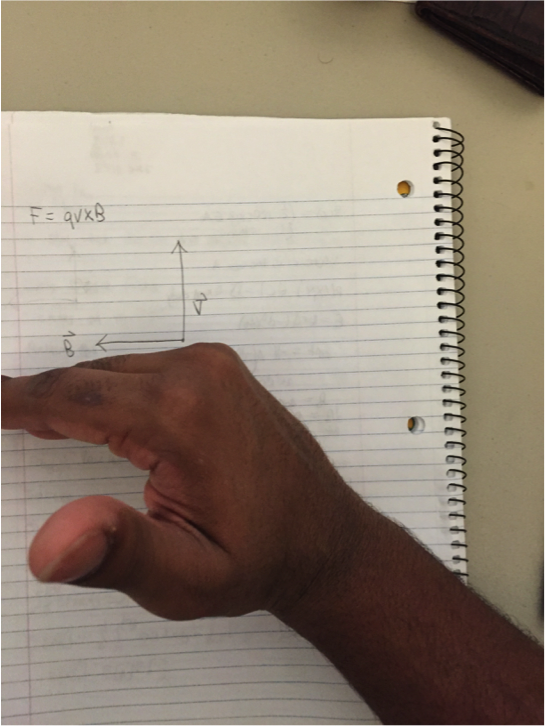Right-Hand Rule: Difference between revisions
No edit summary |
No edit summary |
||
| Line 8: | Line 8: | ||
[[File:RightHand1.png]][[File:RightHand2.png]] | [[File:RightHand1.png]][[File:RightHand2.png]] | ||
===Hall Effect Example=== | |||
===A Mathematical Model=== | ===A Mathematical Model=== | ||
Revision as of 17:14, 24 November 2016
CLAIMED BY AMIRA ABADIR (Spring 2016)
CLAIMED BY Kavin Somu (Fall 2016)
The Main Idea
The Right-Hand Rule is an easy way to find the direction of a cross product interaction before doing the math. For any equation involving a cross product, the right hand rule is a valuable tool for finding the direction. There are two primary ways of using the right hand rule. The first method is to use your entire hand. In the example below, the velocity is pointing north up and the magnetic field is pointing to the left. We place our hand with your thumb sticking up along the velocity since thats the first variable in F= qv X B. You curl your fingers towards the magnetic field. Your thumb is pointing upwards hence the direction of magnetic force is going out of the page.
Hall Effect Example
A Mathematical Model
The Right-Hand Rule is mathamatically modeled by the cross product:
- [math]\displaystyle{ \mathbf{u\times v}=(u_2v_3\mathbf{i}+u_3v_1\mathbf{j}+u_1v_2\mathbf{k}) -(u_3v_2\mathbf{i}+u_1v_3\mathbf{j}+u_2v_1\mathbf{k}) }[/math]
A Computational Model
The cross product is used to describe many magnetic interactions, for example, magnetic field created by a moving charge or a current and magnetic force on a particle by a magnetic field. Because of this, using the right hand rule, to determine the direction of a cross product, can be a useful to check behind the math for sign errors.
Follow the chart bellow to find which fingers correspond to which vectors.
- [math]\displaystyle{ \mathbf{A\times B}=\mathbf{C} }[/math]
| Vector | Right-hand | Right-hand (alternative) |
|---|---|---|
| A | First or index | Thumb |
| B | Second finger or palm | First or index |
| C | Thumb | Second finger or palm |
Another method for determining the direction of the product orthogonal vector is to place the fingers of your right hand in the direction of the first vector(A). Curl your fingers in the direction of the second vector(B), effectively making the "thumbs up" sign in whichever direction the thumb happens to be pointing. The resulting vector(C) is in the direction in which your thumb is now pointing.
Examples
Magnetic Force on a Moving Particle
- [math]\displaystyle{ \mathbf{F} = q\mathbf{v} \times \mathbf{B} }[/math]
The direction of the cross product may be found by application of the right hand rule as follows:
- The index finger points in the direction of the momentum vector qv.
- The middle finger points in the direction of the magnetic field vector B.
- The thumb points in the direction of magnetic force F.
For example, for a positively charged particle moving to the right, in a region where the magnetic field points up, the resultant force points out of the page.
Magnetic Field made by a Current
- [math]\displaystyle{ \mathbf{B} = \frac{\mu_0I}{4\pi}\int_{\mathrm{wire}}\frac{\mathrm{d}\boldsymbol{\ell} \times \mathbf{\hat r}}{r^2}, }[/math]
The direction of the cross product may be found by application of the right hand rule as follows:
- The thumb points in the direction of current I.
- The index finger points in the direction of the observation vector r.
- The middle finger points in the direction of the magnetic field vector B.
For example, for a current moving out of the page, the magnetic field points up, when the observation location is to the right of the current.
Force on a Current from a Magnetic Field
- [math]\displaystyle{ \mathbf{F} = \mathbf{I} \times \mathbf{B} }[/math]
The direction of the cross product may be found by application of the right hand rule as follows:
- The index finger points in the direction of the current I.
- The middle finger points in the direction of the magnetic field vector B.
- The thumb points in the direction of magnetic force F.
For example, for a current moving into the page, in a region where the magnetic field points up, then the force is to the right of the current.
References
--Cjacobson7 (talk) 13:45, 10 November 2015 (EST)

